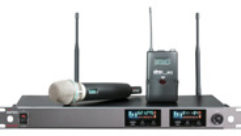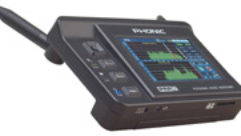
Audio Review: Mipro ACT Series
Sep 1, 2008 12:00 PM,
By John McJunkin
New wireless system provides quality audio without bells and whistles.

Mipro has introduced its new ACT-51 and ACT-52 wireless receivers (1-channel and 2-channel versions, respectively) intended for use with its ACT-7H, ACT-5H, ACT-7T, and ACT-5T transmitters. The “H” designation indicates a handheld microphone, and the “T” designation indicates a body-pack transmitter. I had reviewed another Mipro wireless system in these pages before (see svconline.com/avcontrol/products/avinstall_mipro_act) and I was quite impressed. Taiwan-based Mipro distinguishes its ACT-81 and 82 as “professional wireless receivers” and the ACT-51 and 52 as “standard wireless receivers” and the pricing reflects that distinction. In an attempt to get a handle on the major differences between these systems, I chose not to be presumptuous about anything in regard to the ACT-51/52, in consideration of the fact that I was very impressed with the ACT-81/82. I took nothing for granted regarding the quality of the newer, less sophisticated system, and I dug in to find out all about it.
ACT stands for Automatic Channel Targeting, and this is one of the brilliant features of these systems. A super-simple process of pressing two buttons in sequence finds an available frequency and sends it out to the transmitter, which in turn locks in on that frequency, and that’s it — you’re good to go. The receiver itself is also very simple: The front panel features just five momentary push-buttons, including the power switch (there are nine on the 2-channel ACT-52.) The others are the scan, ACT, and squelch-up and squelch-down controls. The scan button instructs the receiver to find an available frequency. Once that process is complete (typically in just a few seconds), the ACT button is pressed with the transmitter’s infrared port within 11.8in. of the receiver. This transmits the established frequency to the mic transmitter via infrared, and then the setup is complete — signal level appears on the receiver’s front-panel meter.
The front panel’s two squelch buttons are used to determine the level of squelching, which is also nicely displayed on the unit’s Vacuum Fluorescent Display (VFD). If you read my previous Mipro review, you’ll know that I was truly impressed with the VFD. The display of the ACT-51 (of which there are two on the ACT-52 front panel) is less sophisticated, because it doesn’t need to display nearly as much information as the display on the ACT-81/82 units. Nevertheless, it still delivers a clear, vivid color display of pertinent information — including RF signal level on eight preprogrammed channels, audio level, diversity antenna reception, frequency in megahertz, interference warning, channel lock, transmitter battery life remaining, and squelch level. The ACT-51 and 52 lack displays of PC-control remote address and group display, which are not necessary because this standard model does not have the capacity to be controlled by a computer. The major distinction between the standard and professional systems is that the pro versions sport 10 preset equalization curves, security encryption, and computer control. If these are not important to you, a nice chunk of change can be saved by purchasing the standard version.
The receiver’s rear panel features two coaxial antenna ports, a DC-power inlet, and both XLR and TRS audio outputs, along with a slider switch to change output level from -6dB to 0dB to +10dB, in the case of the TRS output. A ground post is also included on the back panel. This is incredibly simple, and that’s exactly what Mipro intends with this system. The receivers take up 1/2RU of real estate, and they can be mounted one or two at a time in a standard rack space. I like the fact that with two ACT-52s, it’s possible to have four channels worth of receivers in a single rack space — pretty efficient.
Mipro shipped me an ACT-51 receiver with an ACT-7H handheld transmitter, topped with an MU-79 condenser capsule. This handheld microphone sounds fantastic. The frequency response is pretty smooth, with a bit of a bump in the high end — which could potentially even require a bit of EQ to reign in. There is a bit of proximity effect, which is to be expected in the case of a cardioid mic, and most vocalists and speakers — even if they’re not professionals — are aware of it and react accordingly. In spite of the capsule’s metal-grille-within-a-metal-grille design, plosives are a bit of a problem. They are easily cured with proper mic technique and a high-pass filter if proper usage doesn’t quite do the trick. Otherwise, this mic sounds great. There’s plenty of resolution in the high end without ridiculous hype — particularly up the “air” frequencies. The mids are smooth and pleasant as well. Mipro makes colored end-caps available to distinguish multiple mics on stage — a nice touch. One other minor complaint in regard to this mic is that in spite of the fact that it’s well constructed and feels very solid, the exterior is apparently made of burnished aluminum. It doesn’t provide a lot of grip for handheld use; it seems a bit slippery. I don’t mean to pick specifically on Mipro with this critique — there are certainly plenty of other manufacturers who don’t rubberize their mics or otherwise coat them with a sure-grip surface of some kind. A more easily gripped surface would be very welcome. On the positive side, no cumbersome recharging mechanism is necessary, because these mics operate on standard AA batteries. In touring applications or even for fixed installations, this is very welcome because these batteries are very readily available and it’s easy to maintain a stock of them on hand. Bottom line: This is a great transmitter/capsule combination, and I’m betting that Mipro’s other capsules sound great as well.
So, how do the ACT-51 and 52 stack up against the excellent ACT-81 and 82? Obviously, there are features in the more sophisticated ACT-81/82 that are not found in the newer system, but that is to be expected in consideration of the lower pricing of the newer system. Clearly, Mipro wished to develop a more affordable solution that provides the same level of audio quality without all the bells and whistles of the ACT-81/82, and I would submit that it’s really nailed it. The VFD is gorgeous, and it presents a wealth of pertinent information to the user in virtually any situation, regardless of lighting conditions. The build quality is solid, and the audio quality is every bit as pleasing as that of the ACT-81/82 systems. Another major advantage with these systems is simplicity of use — the two-button frequency seek-and-lock process is a very welcome time-saver and frustration-eliminator. If you don’t need encryption, EQ presets, or computer control of your receiver(s), the ACT-51 or 52 will not only suffice, but make you very happy. I can strongly recommend the consideration of these systems.
John McJunkin is the principal of Avalon Podcasting in Chandler, Ariz. He has consulted in the development of studios and installations, and he provides high-quality podcast-production services.
PRODUCT SUMMARY
- Company: Mipro
www.mipro.com.tw - Product: ACT series
- Pros: Dead quiet, great fidelity, very easy to use.
- Cons: MU-79 capsule a bit susceptible to plosives, grip on mic feels slippery.
- Applications: Any application that requires wireless mics.
- Price: $450 (ACT-51/ACT-7H); $850 (ACT-52/ACT-7H)
SPECIFICATIONS
ACT-51/52 receivers
- Dimensions: 8.3″×1.7″×8.1″ (L×H×D)
- Weight: 2lbs.
- Sensitivity: 6dBµV, at S/N>80dB, 40kHz deviation
- Maximum deviation range: ±68kHz, with level limiting
- THD: <0.5% @ 1kHz
- Signal-to-noise ratio: >105dB (A-weighted)
- Frequency response: 50Hz-18kHz ±3dB, with HPF
- Maximum output level: +10dBV/0dBV/-6dBV
ACT-7H transmitter
- Dimensions: 2″×10.4″ (W×L)
- Weight: 9.52oz.
- RF frequency range: UHF 620MHz-950MHz
- Bandwidth: 24MHz
- Spurious emissions: <-55dBc
- Maximum deviation range: ±68kHz
- Maximum input level: 140dB SPL









